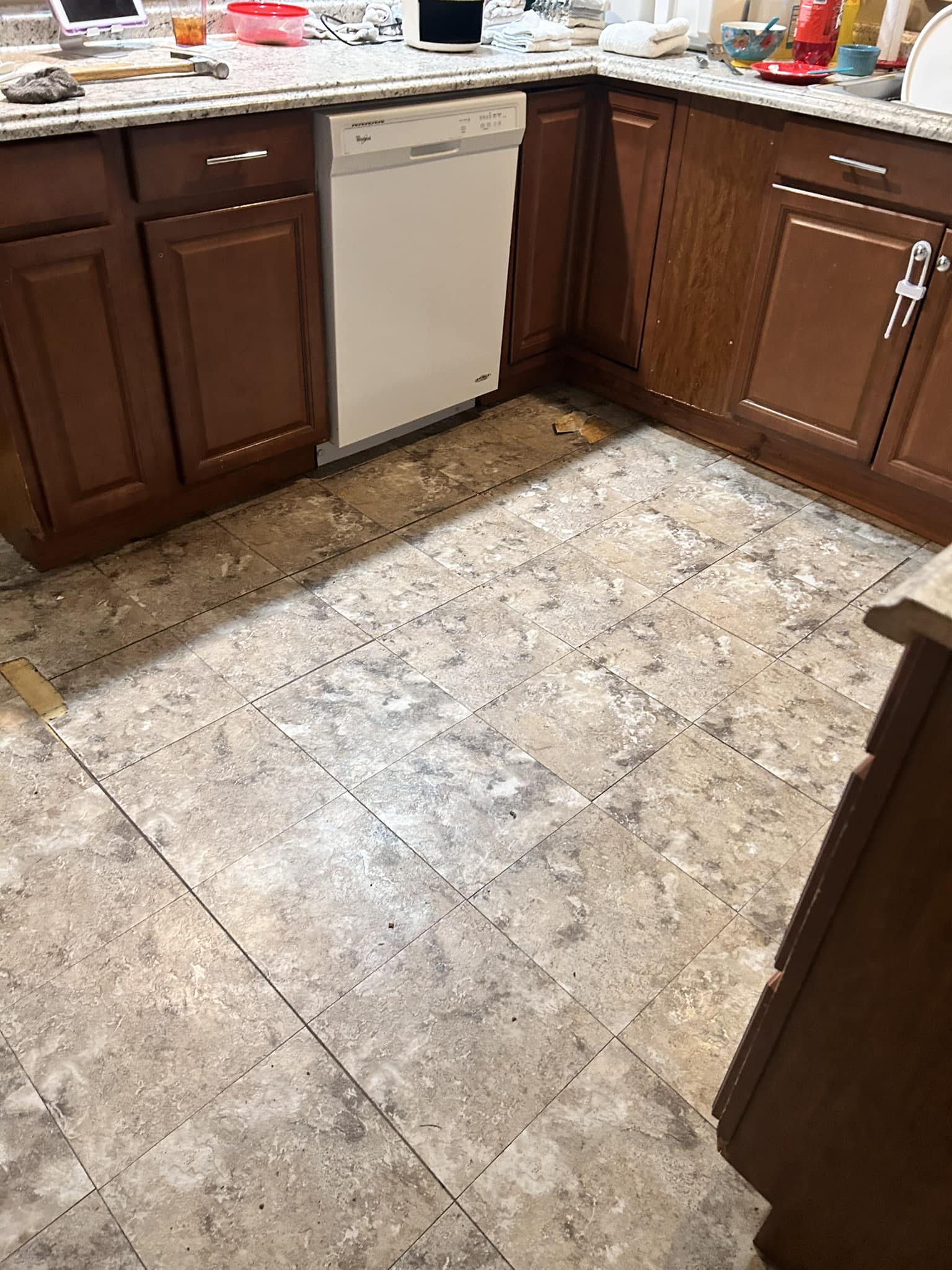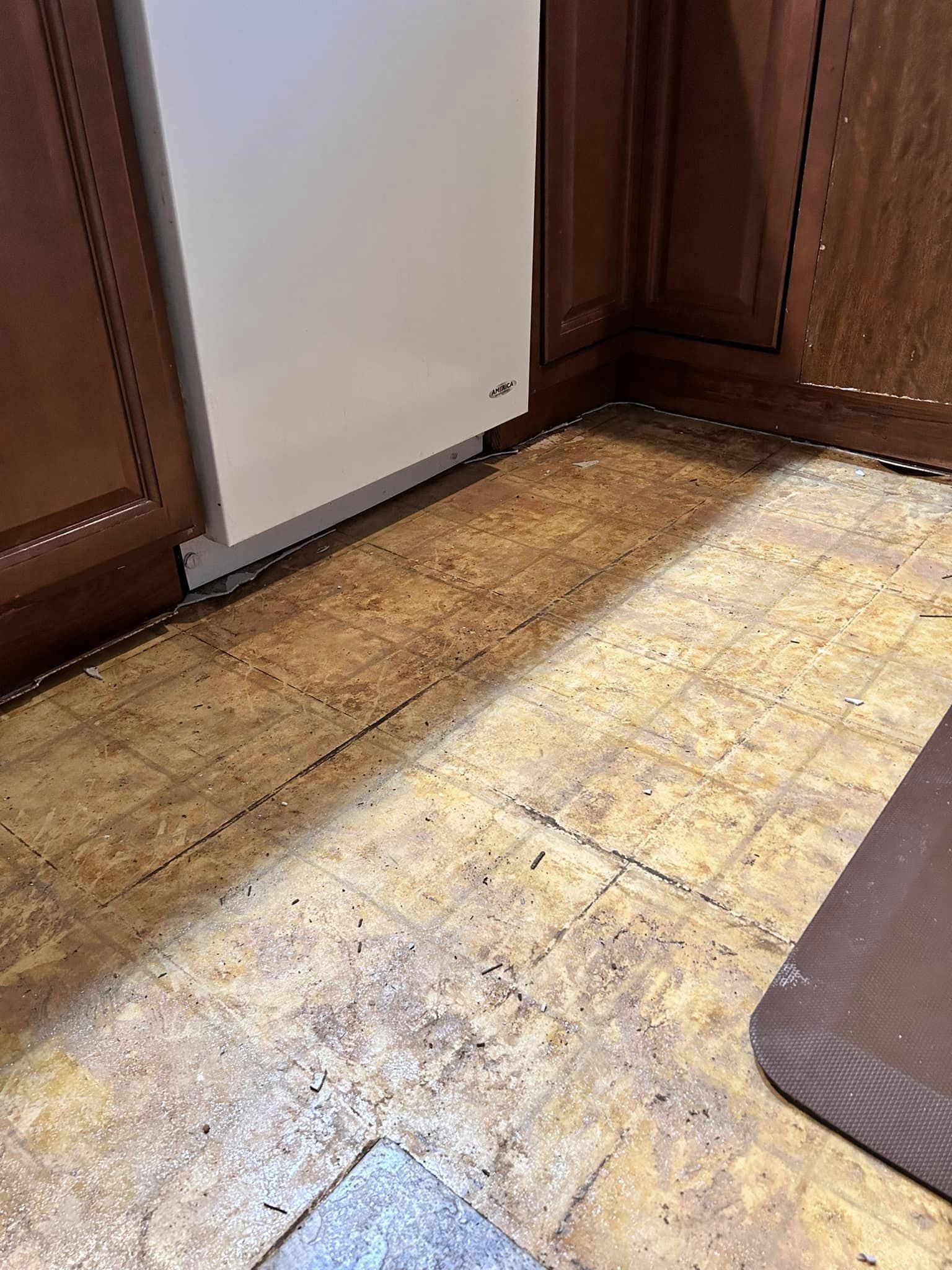Should we remove the sticky adhesive before laying underlayment for Smartcore Ultra LVP in the kitchen, and does the new flooring need to go under all appliances?
1 year ago
Last Updated: May 2, 2024
We’re in the process of installing Smartcore Ultra LVP in our kitchen. Just removed the old flooring, which I think was sticky vinyl tiles, right? Underneath that, there’s more old flooring, but we’re leaving it be because our house is older and there could be asbestos. So, two questions for you guys:
1) Do we need to remove the old sticky adhesive before laying down underlayment?
2) Should the new flooring go under all of our appliances? Google has given me so many conflicting answers, I’m even more confused now.
Any tips or advice would be greatly appreciated! The pic on the left is the first layer we took off, and the one on the right is what we found underneath.


The flooring installer sprinkled powder on the adhesive before installing the LVP. We placed the flooring beneath the stove and refrigerator, but not the dishwasher. We’re not professionals, though.
We placed it under all of the appliances (it’s easier to clean that way), just double-check to ensure the dishwasher has enough space under the counter.
Make sure to confirm with Smartcore if it’s okay to use an underlayment. The manufacturer warned that the warranty could be voided if underlayment was used last time. We usually place it under the stove, range, and dishwasher for easier appliance removal.
You don’t have to remove the glue before installing the underlayment. Just make sure to follow the warranty instructions for the underlayment and padding. I would recommend placing it under all appliances.
LVP shouldn’t be placed under cabinets, but it’s suitable for installation under appliances such as the dishwasher, fridge, and range. This can make servicing the appliances or cleaning the area behind them more convenient. Regarding the sticky adhesive, when my family DIY-ed the flooring in my mom’s 1969 home, we removed it and opted for tile instead. Despite going through the process gradually after work hours, we faced some challenges with the adhesive. A professional later tiled over the remaining adhesive, which led to loose tiles a decade later. My husband and brother had to carefully remove, clean, and re-lay the tiles without any spare tiles to spare. Based on my experience, it might be best to remove the black adhesive, although since you’re installing a floating floor, it may not be necessary.
I couldn’t find specific instructions for the brand of flooring you mentioned, but I did come across these ones for a different brand of LVP. It mentions not placing it under cabinets, but you can still place it under appliances like stoves and refrigerators if needed. If the adhesive is uneven, it’s best to remove it; otherwise, leaving it should be fine. Here’s the link: https://images.thdstatic.com/catalog/pdfImages/ac/ac733886-9bc6-4982-bdcd-a3d4702718a1.pdf
Before sending the sample out to confirm, remember to protect yourself and cut a small piece of tile from the old flooring to check for asbestos.
In our case, we opted for the same flooring throughout. It’s important to note that each type of flooring requires its own underlayment, so be sure to acquire that as well. While we extended the flooring under most components, we left out the cabinets and dishwasher. The process of removing multiple layers to reach the original subfloor may seem tedious, but the end result, with appliances perfectly level with the countertop, makes it all worthwhile.
When installing new flooring, it should go under all appliances, including the dishwasher. This will make it easier to move them in the future. Drawing from my extensive kitchen remodeling experience, I emphasize the importance of following the specific requirements for laying down new flooring to ensure warranty coverage and strong joints. A maximum variance of 1/8” in 8 feet is usually recommended.
We lifted up one stick and peel tile after another, until we reached the hardwood underneath. It was quite sticky. To ensure the vinyl planks could float as intended, we added an underlayment below them. We also caulked around the edges for waterproofing. Ideally, flooring should extend under cabinets and appliances for a more cohesive look.
I agree with other comments. Remove the appliances and install flooring underneath. You’ll appreciate it later on. As for removing glue from old tiles, I personally didn’t do it and had no issues. It’s really up to personal preference.
What type of underlayment should I use?
Here’s what I’ve accomplished (or would do): If the original floor is stable, it’s best to keep the flooring with asbestos undisturbed. Asbestos is safe when stable. Apply talcum powder on the sticky spots. Use underlayment recommended by the manufacturer. Place LVP under all appliances except cabinets. I’ve used odd length pieces under the dishwasher or fridge, where they weren’t visible due to length mismatch. Best of luck!
It might sound crazy, but I’ve been laying down flooring for 15 years. To eliminate the stickiness, grab a small bag of floor preparation material and carefully spread it around the room. After that, use a shop vac to remove any excess material. If you skip this step, your floor will start to stick and make noise when you walk on it. I’ve also worked with smart core a lot and have never needed an underlayment.
Kevin s, the main reason we’re considering underlayment is because our kitchen gets drafty and the floor is consistently cold. I’m hoping it will make a difference.
Make sure you are able to remove the dishwasher regardless of how you decide to do it.
The most crucial aspect is that the previous homeowners of my house neglected underlayment, and I faced the consequences.